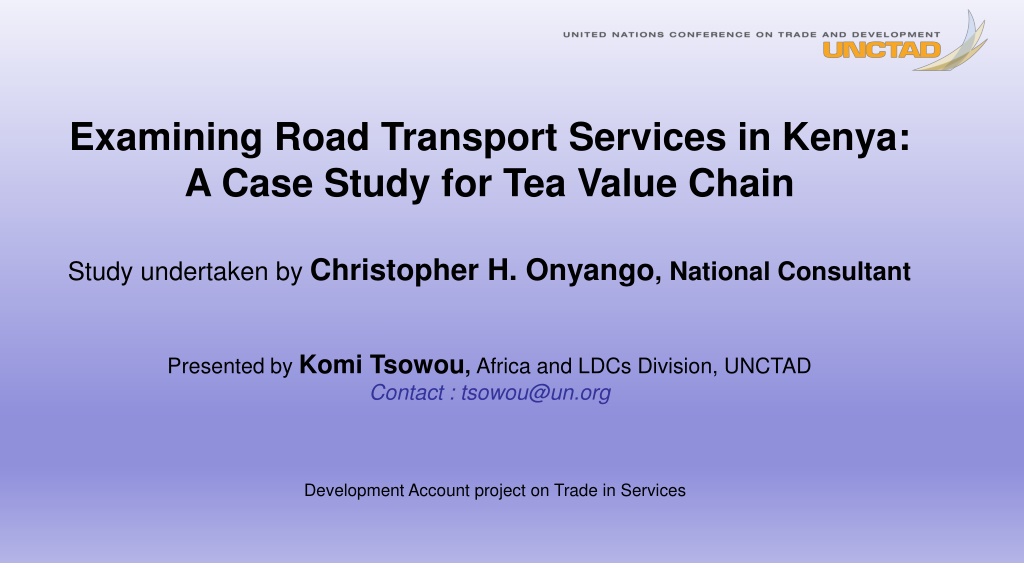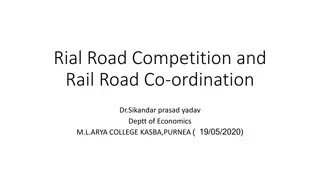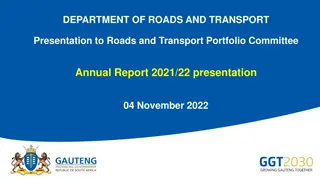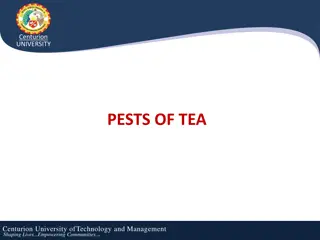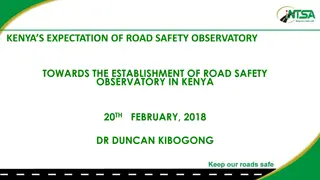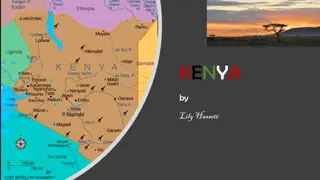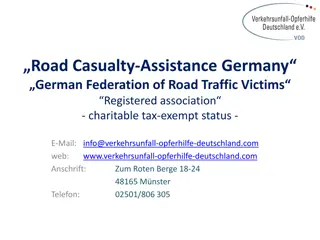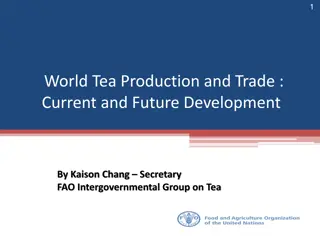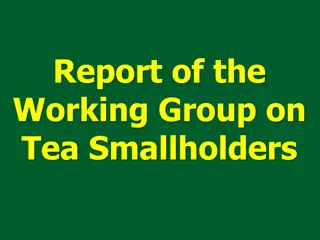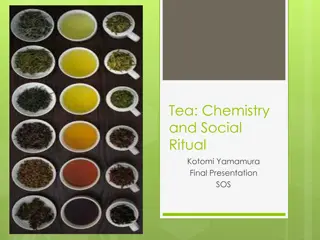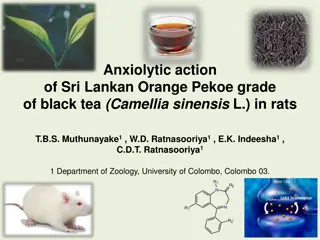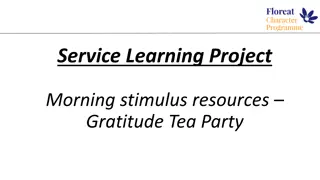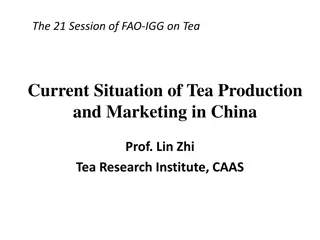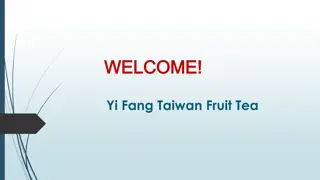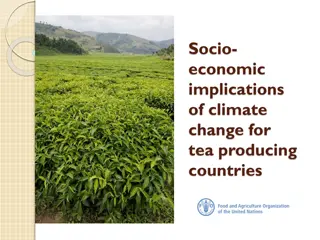Examining Road Transport Services in Kenya: A Case Study for Tea Value Chain
Context and objectives of a comprehensive study conducted in Kenya to analyze the impact of road transport services on the tea value chain. The study aims to assess the contributions, challenges, and opportunities within the road transport sector and provide policy recommendations for enhancing its role in the tea value chain and the overall economy.
Download Presentation

Please find below an Image/Link to download the presentation.
The content on the website is provided AS IS for your information and personal use only. It may not be sold, licensed, or shared on other websites without obtaining consent from the author. Download presentation by click this link. If you encounter any issues during the download, it is possible that the publisher has removed the file from their server.
E N D
Presentation Transcript
Examining Road Transport Services in Kenya: A Case Study for Tea Value Chain Study undertaken by Christopher H. Onyango, National Consultant Presented by Komi Tsowou, Africa and LDCs Division, UNCTAD Contact : tsowou@un.org Development Account project on Trade in Services
OUTLINE Context and objectives of the Study Methodology Key findings Policy recommendations
Context of the Study Increasing role of services in all sectors Servicificationof economies worldwide; Assessment of economic contribution of services to inform timely & efficient services trade policy making including in the contextofservicesliberalizationunderthe African ContinentalFreeTradeArea(AfCFTA); Intervention undertaken under joint UNCTAD & UNECA technical assistance project aiming to strengthen capacities of national and regional services trade policymakers to measure value chains and design services policy;
Objectives of the case Study Examine the contributions of road transport/freight services to Kenya s tea value chain; Assess the degree to which road transport sector contributes to production and export of tea and associated investments, employment and integration in RVCs; Identify the emerging opportunities and challenges for the road transport services sector; Analyze policy gaps in transport services with a view to improve its contribution to tea value performance; chains and overall economic
Methodology: existing approaches Quantitative approach Qualitative approach Domestic / Foreign value added How much content is domestic and how much is foreign value added ? Case studies Combining secondary data and information; surveys/primary data / Estimating participation; RVC / GVC Assessing services regional and international sources) / in-house supplied services / Intra- sectoral suppliers, etc. outsourcing sources of trade by national, Needs constructed statistical often referred to as input-output tables (from national statistical offices and international data sources);
Case study Methodology Secondary data and information from previous researches / reports, national strategic plans and regulations / Examination of legal and regulatory structure of the road transport services sector Data from Kenya National Bureau of Statistics (incl. the Kenya Economic Survey 2019) and form the State Department of Transport; Interviews with, and data from various entities incl. Kenya Tea Development Authority (KTDA), State Department of Transport, Various transport regulatory agencies (KTB, KeNHA, KURA, KeRRA, National Police Service) and Transport Companies and managers of various Tea Factories
Key findings : Kenya transport services sector in brief Transport services : intermediate input into many other key economic sectors; In Kenya, the transport and storage services accounts for about 8% of GDP (2019) with transport services account for over 36% of total services exports with road sub-sector being pivotal passenger traffic and freight; Road Transport Value of Output 2014 2018 (Ksh millions) 2014 2015 2016 2017 2018 Passenger traffic 313,031 322,161 331,512 348,537 390,073 Freight traffic 282,695 306,884 331,414 349,611 392,808 Total 595,726 629,045 662,926 698,148 782,881 Source: Kenya Economic Survey, 2019
Key findings : SWOT Analysis of Road Transport in Kenya STRENGTHS WEAKNESSES Strong policy, institutional and regulatory framework. Government commitment to infrastructure development. Strong linkages with key sectors of the economy i.e. agriculture, industry and services. Country-wide network opening access of remote areas to new markets, faster freight movements. Coordination and regulatory overlaps between national and counties and amongst several national government regulatory agencies Too many controls, licenses and fees for road users raising operation costs. High freight rates and transport costs due to corruption and delays in road blocks. Poor rural road conditions and maintenance OPPORTUNITIES THREATS Expansion of the road networks across all 47 counties and in tea growing areas in support of growth and development of agriculture, manufacturing and other services sectors. Job creation in agriculture and associated sectors, including tourism, business services and retail and wholesale services Geographical positioning as gateway to Africa from the Middle East and Asia. Construction of the new corridor from Lamu to South Sudan and Ethiopia Complementarity with Standard Gauge Railway /Redevelopment of the Northern Corridor / Facilitate rapid shipments and export trade High taxation burdens including tolls, fees for various licenses and VAT on transit goods Corruption especially during award of tenders for construction. Poor workmanship of new roads due to corruption Competition from the Standard Gauge Railway on cargo implying additional investments to establish links by tea industry players Climatic changes resulting into floods, destroying existing roads. Rising fuel costs rendering road transport non-competitive.
Tea sector in Kenya an overview Tea, a leading cash and industrial crop: 600,000 smallholders contributing 60 % of total tea production; 25.6 % of the marketed agricultural production (2018) ; 25 % of total export earnings amounting to USD 1.27 billion (KNBS, 2019); Limited value added at national level : 14 % of Kenya is processed locally; Small scale farming (bellow 0.2 ha) constitute 71 per cent of all tea growers; Large scale farming comprise of those landholding more than 10 hectares; Small-scale farmers sell their produce to 65 factories across the country managed by the Kenya Tea Development Agency; Large scale/industrial tea are represented by the Kenya Tea Growers Association (KTGA) which mainly comprises of large-scale producers who process their own tea. Approximately 45 members;
Key findings: Transport services in Kenya Tea value chain Transportation of green tea leaves from farms to factories : tea companies use in-house fleets of vehicles Tea production Processing Transportation of processed tea from factories to warehouses and markets various modes of transports Markets Source: Kenya Tea Development Authority
Key findings : cost structure of leaf transportation Lleaf transportation: salaries and wages constitute the greatest share of costs followed by vehicle fuel & lubricants ( according to data from KTDA). Cost rate contribution to the leaf transportation 0.00% 5.00% 10.00% 15.00% 20.00% 25.00% 30.00% 35.00% 40.00% 45.00% 42.59% Salaries & Wages 42.70% 7.81% Vehicle Maintenance 7.95% 22.38% Vehicle Fuel & Lubricants 21.81% 4.78% Tyres 4.72% Source: Kenya Tea Development Authority, 2019
Key findings: main inputs of transport services Fleet Tea companies have long term agreements (LTAs) with the services suppliers Tea companies have LTAs with the major suppliers of fuel and tyres, which usually run for two years then its retendered Fuel and Tyres Factories employ their staffs (drivers, mechanics, loaders) Long term plans are to outsource labour in non- core areas. Labour
Key findings - Out-Sourcing Transport Services : why? Tea from the factories to warehouses / markets : why out-sourcing ? High initial investment/fixed/operating costs for owning and operating the services in-house compared to out-sourcing the services; Save costs associated to compliance to regulatory requirements in transport services sub-sector Investments and other Costs Benefits associated with external economies of scale that out- sourced service providers enjoy; Out-sourced transport firms operate regionally in Uganda, Rwanda, South Sudan and Tanzania thereby making them more efficient and cost effective External economies of scale Out-sourced companies combine both transport and other logistics including warehousing and insurance services --- efficiency Bundling of services is an important source of innovation and promotes competitiveness and profitability. Product/services bundling
Key findings : Main constraints and challenges Poor state of roads infrastructure : 11.6% of total road network paved in 2018( worse in agricultural producing areas) cost and delay in tea transportation services; High fuel and vehicle maintenance costs with persistent rise in oil prices Multiple fees and user charges along transit routes transit Transport charged across counties ; Poor data collection and information management due to information gaps on transport services due to reluctance by businesses to share data Implications of the Standard Gauge Railway : fear among tea transporters that legal requirements for all cargo to be transported by SGR will hit tea sector as are houses are at present located far from the rail lines; Multiple layers of authority, and unpredictability of regulations : Road transport is controlled and managed by multiple government agencies and institutions in national and county governments
Key findings : policies affecting transport services costs Licensing regime of motor vehicles which require inspections, fitting trucks with speed gargets are all costly and directly borne by the tea factories; Unpredictable and poorly coordinated enforcement of traffic rules and regulations affect efficient delivery of transport services in the tea sector. Relatively heavy fines promote briberies to enforcement officials, raising the cost of delivery of services; Trade policies also affect operations of the sector. For instance, imposition of full import duties (25%), VAT (16%) and related taxes on tyres and motor vehicle spare parts have direct effects on domestic services prices.
Key findings Opportunity : technology upgrading Technological modern fleets ( based on data from KTDA) Increased efficiency in leaf collections instance, it has improved haulage rate for instance 200 to 240 bags by truck/ vehicle turn-about time has also improved from 3 hours to 2.5 hours; advancements : Investments in --- For Improvements in cost effectiveness, particularly in terms of reductions on maintenance costs, less fuel consumptions and improved quality of green leaf as the result of improved vehicle turn-about; Overall improvements in service delivery as far as in- house transport is concerned;
Policy recommendations Incentives to ease burdens and boost businesses confidence (tea companies) wiling to invest in in-house transport (e.g tax reduction for bulk importation of spare-parts and related accessories). Reduction of Non-tarrifs barriers police road blocks and rent-seeking phenomenon associated with them in transit transport services, especially Sensitization of truck owners and drivers on the need to comply with rules and regulations; Collection of transport services trade data using modern technology in order facilitate identification and measurement of value added in services to support policy -making;
Policy recommendations Resource mobilization to improve maintenance and standards of unclassified roads by consolidating national resources to sustain financing of road transport with focus on proper maintenance of standards and upgrading feeder roads, especially in tea growing areas; Effective coordination and management of road transport policies and regulations by reducing multiple layers of institutions and rules and regulations governing the road sector and streamline compliance; Public-private engagement to build and maintain constructive stakeholder relationships and improvement of government services;
Way forward Interventions under the project in Kenya Plan to implement other tools and methodologies : Quantitative analysis Sectoral COVID-19 impacts and recovery responses :Transport services Action plan including policies to support transport services
